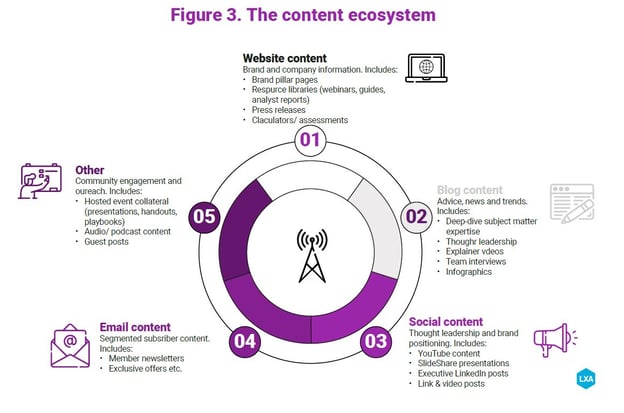Headless and Hybrid CMS Platforms Best Practice Guide
As digital channels proliferate, content increases in importance as the foundation of digital customer experience. This creates a technical challenge for marketers who need to originate and publish content in multiple channels.
This guide will contextualise the challenge facing marketers with regard to content management and offer guidance in terms of how to overcome this challenge via the deployment of headless and hybrid content management systems.
The problem with legacy Content Management Systems
While consumers and clients are used to consuming content and purchasing via multiple channels, some old school Content Management Systems (‘CMS’) are unable to deliver consistent experiences across those channels. That’s because many legacy CMS platforms have a standard or ‘template-based’ interface, or “head”.
This predefined frontend, or “head” was designed to display the content and functionality provided by the CMS backend. This was fine when businesses only had a website to manage but in an environment where B2C and B2B customers expect to engage and transact via multiple channels, a more scalable solution is required.
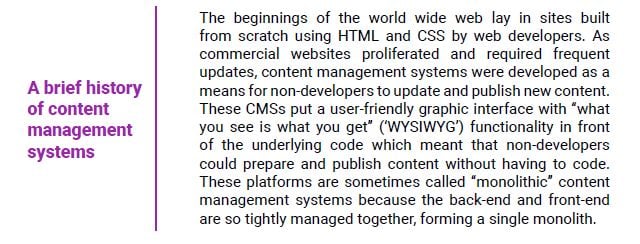
Unfortunately, many monolithic CMS platforms can hinder your ability to streamline the publishing of content in multiple channels because they weren’t designed with this in mind. This results in disempowered content teams using inefficient processes which delays content production and curbs creativity at best; and delivers inferior cross-channel experiences for customers at worst.
Modern marketing requires modern content management
“Headless” content management systems are any type of back-end content management system where the content repository, or “body” is separated or decoupled from the presentation layer, or “head”. Content that is stored in a headless CMS is delivered via application programming interfaces (APIs) for seamless display across different channels and devices.
This means that headless CMSs let you publish content beyond your website to blogs, email, social media and smart devices.
The headless approach offers this flexibility thanks to the API-first approach that allows you to store content in a headless CMS but display it where you (and your customers) need it. This is good for managing and publishing content and it’s good for customer experience.
What is Headless Content Management?
Headless Content Management decouples the front-end content management components (e.g., the content editor and input tools) from the backend technology that delivers and displays the content.
There are no “what you see is what you get” (‘WYSIWIG’) editors or templates built into headless systems. This means that content creation, storage and display all function separately from each other. A headless CMS acts as a content repository where content can be called to populate different content destinations via APIs.
Headless platforms use APIs to pull content from a content repository and send it to a final presentation tier (e.g., website, digital campaign, app, etc).
The decoupling of the front and back-end layers is what makes the CMS headless. Without a head, the CMS is much more flexible than traditional systems because it’s not tied to one website content platform like Wordpress or Drupal.
Figure 1: Headless CMS illustration
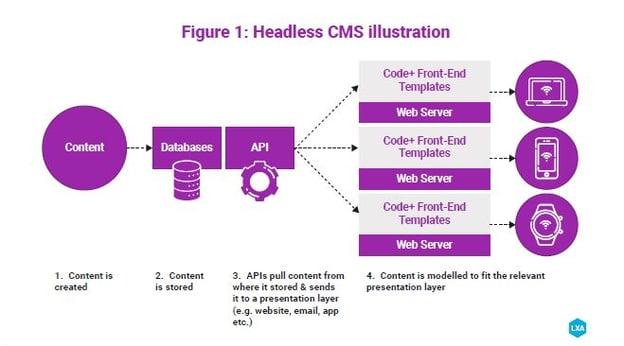
Headless CMS Key Functions Explained
- APIs: Headless CMS platforms rely on APIs to connect and deliver content to different sources.
- Content modelling: Headless systems don’t tie users to predefined content models, but instead allow you to customise a content structure that specifically addresses your business and content needs.
- Multi-language publishing: Headless CMS platforms enable developers to deliver content using any frontend framework. They aren’t locked into the proprietary language/framework of a given CMS so content can be localised more easily.
- Content management: Just like with traditional CMS platforms, headless CMS systems let you create, update, review, delete, and store your content in multiple locations including locally and in the cloud.
Headless CMS platforms make content reactive, meaning it can be repurposed across many channels, devices, and platforms (e.g., mobile, smart devices, social media, etc.)
Pros of a headless CMS
- Complete control over your content execution (where/how/when it appears).
- Frees developers and marketers to focus on the content delivery framework and content deployment.
- Easily integrates with new technology due to API-first infrastructure (scalable).
- Offers fast/flexible content delivery.
Cons of a headless CMS
- Dependent on developers/IT teams to deliver/present content.
- Lacks content presentation functionality (e.g., difficult to preview content).
- Can be costly and time consuming to rely on developers.
- Requires a hefty investment in an IT/development team.
What is a Hybrid CMS Platform?
A hybrid CMS combines traditional, monolithic CMS platform capabilities with a decoupled headless frontend. It includes a user-friendly presentation layer/interface and API-driven features for headless content delivery.
Just like with the headless model, the hybrid model uses a RESTful Content API to execute content requests and enables developers to work in a separate development layer (the head). But a hybrid CMS also includes features for nontechnical users including built in authoring tools and templates.
Figure 2: Hybrid CMS Platform illustration
Hybrid CMS Key Functions Explained
- A Hybrid CMS has the same functions as the Headless CMS, which includes API-driven content delivery, content modelling, multi-language publishing, and content management/storage.
- Dedicated authoring features: WYSIWYG editors, templates, and a user-friendly interface enable nontechnical users to manage content and understand how it will appear after being published.
- Headless + coupled/decoupled capabilities in the same platform: Marketers don’t need to involve IT to quickly deploy content to new or updated channels.
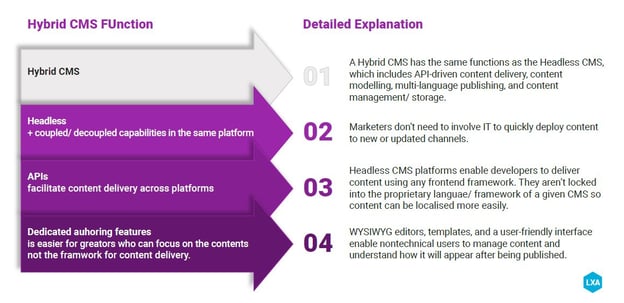
In other words, a Hybrid CMS can deliver content on any platform, and also has the advantage that marketing teams can manage and rapidly deploy content across channels independently of IT.
Just like fully headless CMS platforms, hybrid solutions make content reactive - you create content and wait for a device, such as a smartphone to request it. Hybrid platforms also provide enhanced authoring capabilities which means fewer dependencies on IT for content delivery.
Pros of a hybrid CMS
- The flexibility of headless with the functionality of a traditional CMS.
- As with headless, security is better with hybrid since content/user data are housed in a separate firewall-protected system.
- Allows you to repurpose/reuse content more easily across multiple outlets.
- Requires less investment in development/maintenance (and/or reduces burden on developers).
Cons of a hybrid CMS
- Content delivery can be fragmented since not all systems are compatible – this may reduce your ability to easily deploy content across all the devices and channels you
- Custom delivery mechanisms are often needed to integrate systems and tools.
- A more complex system than purely headless CMS (often requires extra front-end development and overall maintenance).
Why do I need a Headless / Hybrid CMS Platform?
- Seamless content delivery across channels, devices, and platforms is critical for creating a good customer experience. This is the main reason to go headless when it comes to content. Forrester reports that 61% of U.S. adults won’t return to a website after a poor experience, regardless of the quality of the product. (2)
- Headless/hybrid CMS platforms allow for content agility, enabling marketing teams to quickly create, coordinate, and deploy content across the many different channels consumers are using. This translates to a better overall experience for customers who are interacting with businesses (and their content) via more devices and channels than ever before.
- A headless/hybrid CMS approach reduces IT dependency, enabling marketing teams to activate content across an entire ecosystem of sources, including blogs, websites, social media, mobile apps, email, IoT devices like smart speakers and TVs.
- The content ecosystem encompasses so much more than your website or app. Headless and hybrid CMS systems allow you to adapt and grow much more easily than monolithic systems.
Figure 3. The content ecosystem
Where the headless/hybrid CMS sits in the tech stack
A CMS is central to your overall tech stack. It is a crucial spoke in the wheel that turns your entire business technology infrastructure. While it doesn’t necessarily sit in the centre of your tech stack, it plays a prominent role in the content stack.
In the MarTech Alliance / Moore Kingston Smith 2021/22 Martech Report, CMS platforms landed at the bottom of the list of martech tools that businesses had added in the past 12 months. But they fell within the top five major martech tools that organisations were planning to add over the next 12 months. (3)
They’re right up there with ecommerce platforms, DXPs, and marketing analytics/attribution platforms.
Figure 4. Major martech tools UK organisations plan to add in the next 12 months (3)
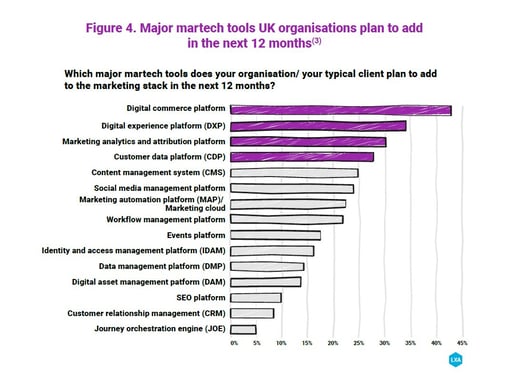
Why should marketers consider a headless and hybrid CMS?
Headless and hybrid CMS platforms give businesses the flexibility to activate content across this ever-changing (and expanding) digital ecosystem. They also break down content into smaller components which can more easily be repurposed depending on how they’re consumed.
Why should you care? We’ve boiled it down to five key reasons.
Top five reasons for marketers to invest in a headless/hybrid CMS
- Create a dedicated content infrastructure
- Enable content and development teams to work in parallel
- Make content reusable and omnichannel ready
- Facilitate content futureproofing
- Button up content security
1. Create a dedicated content infrastructure
Headless/hybrid CMS platforms require you to create a content model and framework. This structure means your content can be repurposed in multiple ways. Content models combine the needs of design, development, and content creation teams and are specific to each organisation’s needs, goals, and way of working.
A content model approach eliminates the content silos, redundancies, and roadblocks inherent with a traditional monolithic CMS. It fosters flexibility and streamlines the process of creating content in a way that can be adapted for use beyond your website. It also helps you define each piece of content, breaking it down into different components, hierarchies, and types. This is tremendously helpful when planning your content strategy and needs.
2. Allows content and design teams to work in parallel
A key benefit to the headless/hybrid content management approach is that it frees up your content, development, and design teams to focus on their key responsibilities.
Development teams aren’t locked into using one language and framework for creating the content infrastructure. They’re free to explore and utilise whatever tools they need for the delivery of content across channels, devices, and platforms.
Headless/hybrid platforms allow content teams to continue working on content projects without worrying about system changes and upgrades. Decoupling the head from the body frees the content team to continue the important work of creating, editing, and managing the day-to-day content without interruption.
3. Makes content reusable and omnichannel ready
With a headless or hybrid CMS system, it’s much easier to repurpose and reuse content once it’s added to the overarching content repository. Purely headless CMS platforms are content agnostic, meaning that the raw content is accessed by APIs and delivered to its destination without a presentation layer.
A hybrid CMS has this same capability but may be less flexible if the solution isn’t format-agnostic. Developers may be locked into a proprietary front-end system which requires more integrations and workarounds for content delivery to certain channels or devices.
With both headless and hybrid approaches, content is much more accessible and reusable across the omnichannel customer journey versus traditional monolithic CMS platforms.
4. Facilitate content futureproofing
One of the biggest benefits to going headless is that it facilitates fast, flexible development within an API-first framework. This makes it much easier to pivot your website and content strategies as trends, technologies, and consumer needs change.
It’s this ability to futureproof the content ecosystem that’s drawing more and more organisations to headless technologies.
Monolithic platforms simply cannot keep up with the proliferation of new delivery channels, devices, and touchpoints that consumers are using. Headless and hybrid CMS tools allow businesses to scale and revise their content delivery approach across channels, create consistency with brand messaging, and optimise their interactions with customers without having to rebuild their content stack from scratch every year or two.
5. Button up content security
Housing all your website content with a monolithic CMS vendor like Drupal or Wordpress makes it vulnerable, particularly as more themes and plugins are added to expand CMS features.
With headless CMS, the administrative and data-holding components are separated from the display layer (e.g., your website). This makes it much more difficult for hackers to find a way in and knock you offline. A headless or hybrid CMS platform limits the elements that end-users can access. It separates the content creation layer from the content delivery layer, so it’s much harder to break stuff.
This framework also makes it easier for developers to update and maintain the system, making it even more secure.
How do I choose a Headless / Hybrid CMS Platform?
As with all things martech, the headless and hybrid CMS landscape is in flux. CMSWire lists over 30 pureplay headless solutions with Butter CMS at the top of the list followed by Contentstack and Contentful (in that order). (4)
Forrester’s latest Agile Content Management Systems Wave report identifies 15 significant headless / hybrid CMS providers with Adobe, Optimizely, and Acquia listed as the top leaders.
A purely headless CMS platform is API-first and focused on developers’ needs, but the obvious demand for marketer-friendly headless platforms is making even these old school headless solutions (Butter CMS was founded in 2014) reconfigure themselves to take a more hybrid approach.
The increasing popularity of hybrid CMS reflects changing needs for content management. Hybrid can enable marketers to deploy content more quickly, but also to deliver personalised experience by channel or device.
The headless and hybrid CMS market is divided into two key offerings—cloud/SaaS and on-premises, with different platforms catering to SMEs versus large enterprise businesses.
When selecting the platform and approach that’s right for your organisation, it’s important to consider the pros and cons of each offering.
The cloud-based model is takes two key approaches:
- Cloud/SaaS: The CMS infrastructure and applications are hosted by the provider in the cloud. No software downloads or installations are required. This typically has a fixed subscription model that users pay monthly or annually. Maintenance costs, IT resources, and security are all outsourced to the SaaS provider, but customization and flexibility can be limited since you’re essentially paying to use an out-of-the box CMS product.
- PaaS: Platform as a service is another approach to headless wherein the service provider provides the entire infrastructure needed for application development (network, server, middleware, OS, etc.) and delivers it through the cloud. Amazon Web Services and Microsoft Azure are examples of PaaS vendors. With PaaS, the service provider maintains data centres and other infrastructure, provides pre-coded application components which help speed up development, and maintain the core development stack.
On-premises CRM: In this scenario, you store the data at your facility and control who has access to the physical system. This is a much bigger animal to tame than a hosted solution. You’re responsible for buying software licences, installing, updating, and maintaining the entire system, and ensuring the entire system is secure. Tridion and OpenText are examples of providers that offer an on-premises option.
Hybrid or headless: which should you choose?
There’s no cut and dry answer to the question of whether to go completely headless or use a hybrid approach.
Different use cases lend themselves to different solutions. So when considering headless versus hybrid, we suggest you look at common business use cases for both and apply them to your own unique scenario.
Regardless of the use case, it’s important to keep the main benefits in mind before making the switch from monolithic to headless.
Here’s a quick recap of the benefits:
- API-driven content delivery that can send content to any channel
- Fast, flexible development independent from content authoring functions
- Much (much) easier to deliver and scale omnichannel experiences
- Future proofing thanks to easy integrations and API-first model
- Better security thanks to the separation of presentation, development, and storage layers
Here are some common business use cases for headless and hybrid CMS platforms that can help you decide which is best for your business.
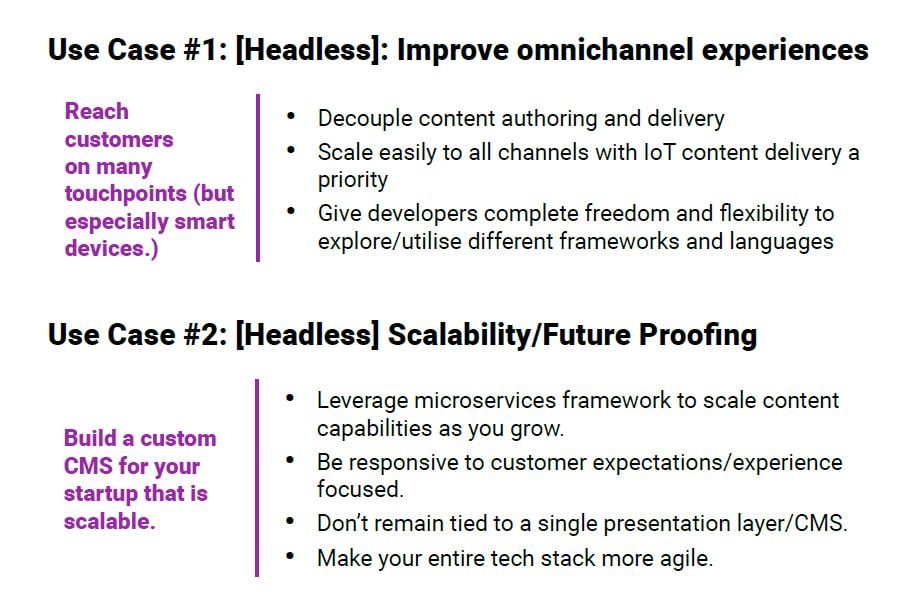
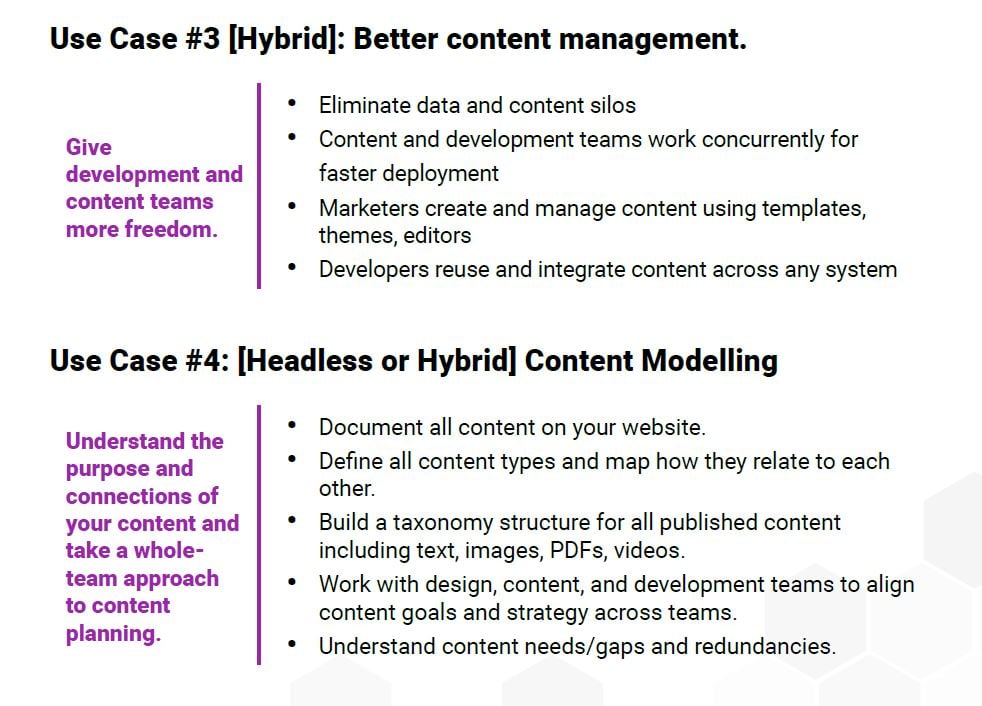
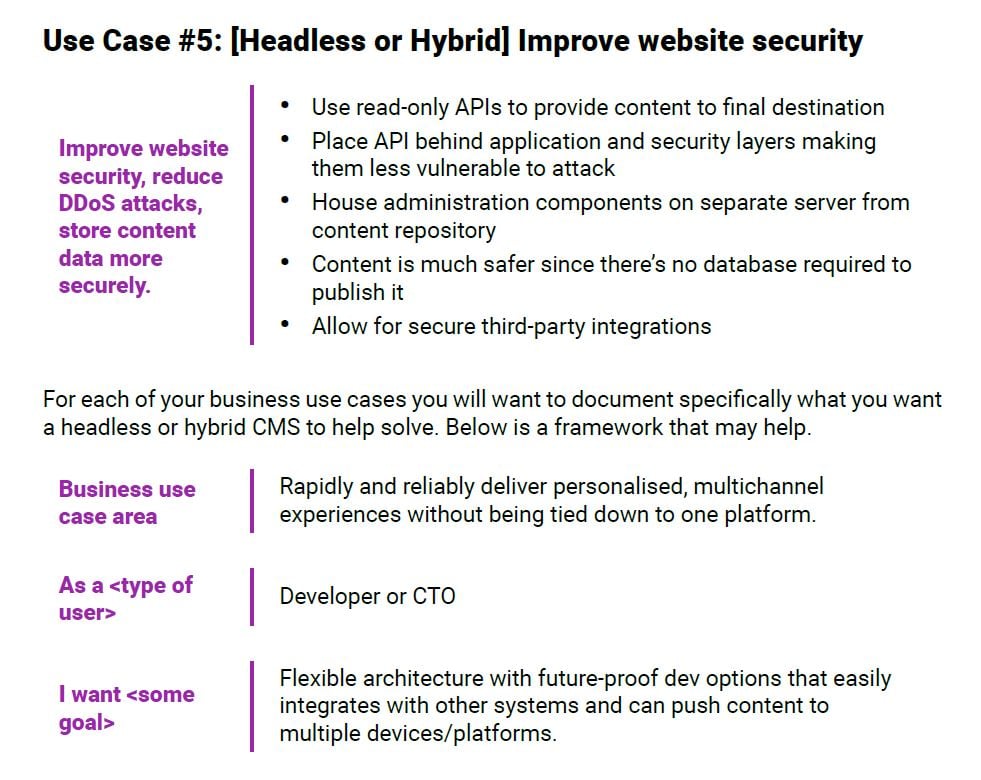
For each of your business use cases you will want to document specifically what you want a headless or hybrid CMS to help solve.
Here's a framework that may help.
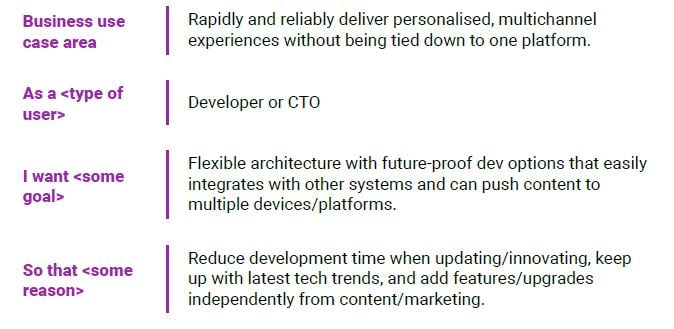
You can make the above framework more relatable by telling a meaningful story, as follows.
Chloe, our Chief Technology Officer needs to replace our outdated monolithic CMS which is cumbersome to use and difficult to customise or integrate with new technologies. She wants a solution that gives her team the flexibility to add new technologies and is easily customizable, while offering more security, and enabling the marketing/content team to work more independently without relying so much on IT. The system must be future-proof, enabling both marketing and IT to draw from a central repository of content so that they can rapidly leverage a proliferation of digital touchpoints and devices, improve the customer experience, and raise brand awareness.
Defining your use cases is key to your RFI/RFP documents proving meaningful to headless/hybrid CMS vendors. This will allow them to understand your exact requirements and showcase how their solution can play this out when they demo their platform vs providing a generic overview of capabilities.
Creating a vendor scorecard to mark each vendor is the next step.
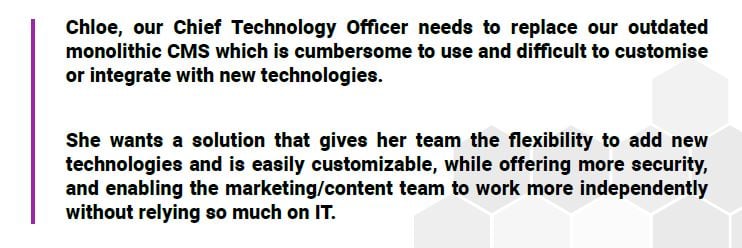

Beyond your business use cases you also want to assess technical architecture fit as well as areas such as product roadmap, training and support, partnership network etc.
We can’t cover every area of a vendor scorecard in this guide, but you can access our vendor scoring model and vendor demo questions check list by joining the LXA Membership.
With your use cases documented, vendor scorecard defined, and RFI/RFP created it’s time to start connecting with vendors.
Creating a short list based on your company profile and preference is a good starting point; CMS type (headless vs hybrid), B2B or B2C focus, functional specialism, industry and company size match.
As you progress to chatting with vendors, we would recommend you:
- Take your time & prepare – Don’t rush the process. Make sure you have done your research to better understand the headless/hybrid CMS space. Ensure you have details of your content needs available and your vendor scorecard and questions.
- Run a custom demo – Make sure vendors have your business use cases and business background weeks before your demo so they can sufficiently prepare and tailor what they present so you can make a fair assessment.
- Get into the detail of your content needs – Get into the nuts and bolts of your needs/goals
- to really assess the ease, speed and cost of getting a headless or hybrid CMS in place.
- Review vendor case studies – Ask for customer case studies showing key results of their platform.
- Assess direct and indirect vendor costs – Ensure you get all costs from vendors from data hygiene and onboarding, custom integrations, consulting, training and any other area beyond the platform licensing itself. If the vendor doesn’t cover all areas, ensure you have forecast what additional investment is needed. This could be consultancy to manage your content modelling or an internal new hire such as a lead developer to be the platform super user.
- Get vendor customer references – and ideally direct access to chat with some of their clients.
Summary
Most midsize and enterprise organisations are dealing with an ever-growing need for content which must be populated across many different content end points. Business leaders who have a clear vision for content are 5X more likely to succeed versus those that don’t. (5)
Headless and CMS solutions force organisations to take a step back from simply churning out content across a patchwork of channels and platforms. The headless approach to content creation requires design, development, and content teams to document existing content, break it down into components, and visualise the best way to leverage it for their specific business. It also enables these same teams to be less dependent on each other when it comes to content delivery, creation, and execution.
Headless/hybrid CMS systems are scalable, but also sustainable, and therefore much better at helping you deliver an exceptional content experience to your customers regardless of what channels, devices, or platforms they use to interact with your business.
Citations
1 Source, Research and Markets: ‘Global Headless CMS Software Market Forecast Report 2020-2027’, Globe Newswire, February 23, 2021. (https://www.globenewswire.com/news-release/2021/02/23/2180124/0/en/Global-Headless-CMS-Software-Market-Forecast-Report-2020-2027-Market-Opportunities-in-the-Rising-Deployment-of-Headless-CMS-in-BFSI-Sector.html)
2 Source: Alfie Powell, ‘Customer experience stats and trends’, MarTech Alliance, 18 August, 2021. (https://www.martechalliance.com/stories/customer-experience-stats-trends)
3 Source: Martech Alliance, ‘The Martech Report 2020/2021’, Martech Alliance in association with Moore Kingston Smith, October, 2021. (https://www.martechalliance.com/martechreport)
4 Source: Kaya Ismail, ‘34 Free or Premium Headless CMS That Should Be on Your Radar’ , CMSWire, Jan 6, 2022. (https://www.cmswire.com/web-cms/13-headless-cmss-to-put-on-your-radar/
5 Source: Content Science, ‘50 Useful Content Facts’, Content Science, 2021. (https://content-science.com/publications/50-content-facts/)


